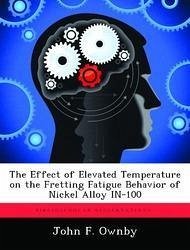This thesis studied the effect of elevated temperature (600 C) on the fretting fatigue behavior of IN-100. First, fretting and plain fatigue S-N curves were determined over a large range of applied stress at an identical stress ratio of 0.03 at 600 C and for fretting tests, with a constant contact load. The partial slip condition was verified by using hysteresis between shear force and axial stress techniques. The contact width and the crack initiation location were observed for all of the fretting specimens. The contact widths were consistent with expected values and the crack initiation location was at the trailing edge of contact for all fretting specimens. This study compared its high temperature results to room temperature testing accomplished by this study as well as room temperature data from a previous study using IN-100 with an identical microstructure and another room temperature study of IN-100 with a coarser microstructure. It was found that fretting fatigue reduces the cycles to failure compared to plain fatigue at elevated temperature but a more pronounced reduction was noticed than with room temperature. It was also found that the elevated temperature environment increased the both the plain and fretting fatigue life as compared to similar stress levels at room temperature. The study found that elevated temperature does have an effect on crack initiation and crack propagation as compared to room temperature environment. The higher temperature allowed a longer initiation and crack propagation time which strongly suggests the fatigue life increases with temperature up to 600 C. The creation of oxide films and temperature induced softening or plasticity were both found to act as crack closure mechanisms in another nickel based superalloy, IN-718, when fatigued in the high temperature environment. It is therefore likely that these oxidation and plasticity crack closure mechanisms are the reasons for the improved performance at elevated tempera These find
Hinweis: Dieser Artikel kann nur an eine deutsche Lieferadresse ausgeliefert werden.
Hinweis: Dieser Artikel kann nur an eine deutsche Lieferadresse ausgeliefert werden.








